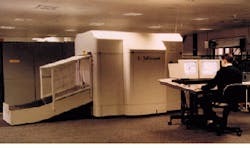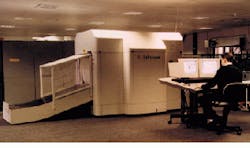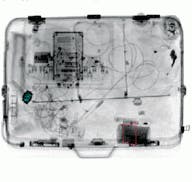Intelligent vision systems TIGHTEN AIRPORT SECURITY
Intelligent vision systems TIGHTEN AIRPORT SECURITY
With the US Federal Aviation Authority (FAA) pressing for new explosive-detection capabilities for baggage and passenger inspection, US Vice President Al Gore has filed an airline-safety report recommending that more than $100 million be spent on computed tomography (CT), x-ray, and other detection systems.
One such system, the CTX 5000 system from InVision Technologies (Foster City, CA), combines CT and x-ray imaging with array-processing and image-analysis software to automatically detect and identify explosives. Currently the only FAA-certified explosives-detection system for baggage scanning, the CTX 5000 is in operation in London (Gatwick), Manchester (England), and San Francisco airports (see Fig. 1).
In operation, the CTX 5000 produces cross-sectional tomographic images of the contents of a piece of baggage by imaging multiple slices. An embedded image-processing system then reconstructs the slices and displays relative densities of individual objects within each slice. The intense amount of computation required to interpret the CT scan images is a significant factor in the system`s throughput rate of 260 bags/hour. To increase this throughput, the company is upgrading the system to inspect 500 bags/hour.
Visualizing images
In operation, a conventional x-ray prescreening unit makes an x-ray scan of each bag. This image is then analyzed to identify specific areas for further cross-sectional analysis by a CT device. These determinations are based on proprietary algorithms that look for specific data such as concentration of mass. At this stage, however, no determination is made on the presence of explosive devices or materials.
Embedded software generates a specific slice pattern for the CT x-ray unit to follow, based on the bag`s contents, and adds additional information that accounts for the characteristics of certain types of explosives (such as sheet explosives). Such explosives are often impossible to visualize with conventional x-ray scanners. The x-ray scan device operates independently from the CT with its own integrated Pentium-based computer running proprietary image-processing software.
After the initial x-ray scan, each bag is passed to the system`s CT x-ray module that has been adapted to meet the operational demands of explosives detection. For example, the system`s gantry, rotating at approximately one revolution per second, is custom-designed for heavy-duty-cycle operation and harsh operating environments. "Whereas hospital CT systems are used about 10% of the time, the CTX 5000 must operate in dusty, hot, and humid environments for 16 hours a day. So the system needs to be rugged, because there is no time for it to cool down," says Stephen Wolff, InVision vice president of marketing and product development.
Handling baggage in a pipeline fashion, the system scans one bag in the CT unit while another is being prepared in the x-ray unit. Motion-control instruments then position each bag for accurate cross-sectional scanning.
Multidimensional images
Unlike conventional x-ray scanning, objects imaged by CT scanning are not influenced by other objects in the baggage. While x-ray scanners superimpose objects onto one another with no depth of field, the CT module is rotated around the baggage, generating different views from which multidimensional images can be reconstructed. Each individual object in the cross-sectional slices is analyzed independently, and a threat-analysis decision is made for each one (see Fig. 2).
The number of slices required for the analysis is determined automatically, depending on what types of objects are found in the bag. Computed tomography identifies explosives through their x-ray-absorption signatures or densities. If something suspicious is discovered, the system uses more than 100 proprietary algorithms to determine if explosives are present. If so, an alarm is sounded, and the bag is kept in a holding area. According to Wolff, the algorithm development necessary to accomplish reconstruction, analysis, and identification was the greatest design challenge.
The CT module`s image-processing tasks are pipelined in three data-handling phases: collection, reconstruction, and analysis. Currently, each process takes approximately one second per slice for a total of three seconds per image. To increase throughput, Invision designed the system to simultaneously collect data from one slice, while data from another are reconstructed and a third slice is analyzed. This pipelined operation allows five slices to be handled in three seconds.
Imaging hardware
The image-processing and data-acquisition computer used in the CTX 5000 is based on the VME bus. It incorporates the Force Computers (Campbell, CA) SPARC-IICE CPU to manage CT data acquisition and handshaking between the static and CT scanning systems, a custom VME I/O-interface board to the CT module, an Ethernet link, and three single-processor, i860-based image-processing boards from Mercury Computer Systems (Chelmsford, MA). These image-processing boards provide the image reconstruction and data analysis for the CTX 5000.
Each CT slice consists of 512 ¥ 512 ¥ 8-bit image data. At present, the system`s processing throughput is 240 MFLOPs, but upgrades are planned that will increase this to 600(800 MFLOPs per image-processor board. InVision is now evaluating a system based on Mercury`s PowerPC Raceway system. Because both the i860 and Power-PC are RISC processors, InVision does not anticipate significant challenges in porting the software. The Raceway I/O architecture will also offer more speed than the VME bus for data transfer from the CT system (see "High-performance processing demands VME extensions," Vision Systems Design, Dec. 1996, p. 40).
Once reconstructed and analyzed, information is fed to the CTX 5000 Sun SPARCstation-IICE system controller that handles all of the image-display functions for both the CT and the standard x-ray system. This CPU also controls all system operations including belt motion, baggage handling, and user interfaces.
The control and display console for the system uses an Intel 386-based computer to handle display and control functions. According to Wolff, a 386-based system is adequate because the console does not have a high data workload or high speed requirement. Both conventional x-ray and CT images are displayed on side-by-side screens for an operator to view.
The console has a mixture of hard and soft key controls and a track ball for the operator to control and manipulate conventional x-ray and CT images with tools such as zoom, sharpen, inversions, and object coloring. Operators also can set up regions within displays to look for other materials besides explosives. Explosives are automatically outlined and highlighted in red, metals and electronics in blue, and detonators in green. "Operators resolve most alerts in less than 20 seconds, with less than 1% of inspected luggage requiring further hand search," says Wolff.
According to Wolff, the system`s upgrade will improve baggage throughput. "At present, throughput is limited by baggage motion time, the number of slices required to analyze each bag, and the time required to process each slice." InVision is improving this throughput time by reducing the time required for image reconstruction.
"By the time one slice`s data are reconstructed and analyzed, two or more slices of additional data have been collected," says Wolff. "But the first slice may reveal that additional data are not required, allowing the time between acquisition and analysis to be shortened. Then, some of the extra data slices and the associated processing can be eliminated."
FIGURE1. Several airports are currently using the CTX 5000 system from InVision Technologies to detect explosive material contained in passenger baggage.
FIGURE 2. The CTX scanner reconstructs cross sections of items in baggage and uses proprietary algorithms to test for a number of different explosives such as canister bombs (right) and book bombs (below). These can then be highlighted with a graphical overlay.
Integrated system combines speed and detection capability
InVision Technologies (Foster City, CA) has formed an alliance with EG&G Astrophysics Research (Long Beach, CA) to develop a multilevel explosives-detection system (EDS) for airport baggage inspection. Although EG&G`s Z-Scan systems are already in use alongside InVision`s CTX 5000 machines at Manchester Airport (England), a system now under development is intended to combine the detection capability of InVision`s system with the 1200 bags/hour throughput of the Z-Scan system. According to EG&G`s Dave deMoulpied, production systems should be available by the end of 1997.
The Z-Scan is a two-view x-ray scanning system, with two x-ray sources scanning at 90 from each other. The system uses three standard off-the-shelf Pentium computers running Windows NT and proprietary image-processing algorithms. Two of the computers are integrated into the main scanning unit, and the third controls a remote operator workstation. The computers communicate with each other and transmit image data over an Ethernet LAN.
Airport EDS systems and procedures are implemented in two ways. In the first, systems such as Z-Scan are integrated into the baggage-handling line, automatically checking each bag as it passes from the check-in station on its way to an aircraft. Any bags that fail to meet the system`s preprogrammed parameters are assigned an ID number and status. The image of the bag is then transmitted to a remote workstation for operator analysis. Operators then have from three to eight seconds to manually reject the bag or authorize it to continue.
Operators have a suite of controls that allows them to zoom, reverse image, and implement algorithms that remove everything from the image except organic materials. Because most explosive materials incorporate organic materials, these algorithms can aid in faster identification of explosive materials. According to deMoulpied, well-trained operators can keep the number of rejected bags down to between 1% and 2%.
If the operator does reject a bag or fails to make a decision, it is routed for further inspection and analysis. This is performed manually with vapor-detection systems or by opening the bag.
At Manchester airport, a different approach is used, which removes the operator from the process. In this procedure, any bag that is tagged by the Z-Scan system is automatically routed to the CTX 5000 system for further analysis. Although this increases the number of bags handled by the CTX, it represents a significant security improvement.
In the next-generation system, Z-Scan will increase baggage-handling capacity of the CTX 5000 by providing cueing data to the system to reduce the number of image slices it needs for further evaluation. Both companies expect this system to process more than 450 bags/hour at US Federal Aviation Authority certification levels.



